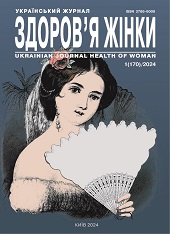Clinical characteristics of women with female sexual dysfunction and endometriosis
DOI:
https://doi.org/10.15574/HW.2024.170.32Keywords:
female sexual dysfunction, endometriosis, estrogensAbstract
Endometriosis is a disease characterized by the presence of endometrial tissue outside the uterine cavity. Endometriosis refers to estrogen-dependent diseases, clinically manifested by dysmenorrhea, dyspareunia, dyschezia. Decreased fertility in women with endometriosis is associated with the presence of chronic inflammation that leads to pelvic pain and infertility. It is believed that endometriosis is associated with mood disorders such as anxiety or depression, which can create a pathological background for sexual dysfunction.
Purpose - to establish the relationship between female sexual dysfunction (FSD) and external genital endometriosis in order to optimize women's pregravid preparation.
Materials and methods. 100 women of reproductive age were examined. The main group (the Group I) consisted of 70 women who had external genital endometriosis (diagnosed by ultrasound examination of the pelvic organs, ovarian endometrioma size up to 5 cm). The main group was divided into 2 subgroups: IA - 40 women with FSD and endometriosis; IB - 30 women with FSD without endometriosis. The control group (the Group II) included 30 healthy reproductively active women in the pre-gravid stage. In the course of the study, the nosological unit approved by the World Health Organization (1999) was taken into account and taken as a basis - FSD, which include disorders of desire, arousal and reaching orgasm, dyspareunia and vaginismus. The results of clinical and biochemical studies were processed using a specialized package of statistical programs Statistica 8.0 (StatSoft Inc., USA). The following criteria were used for statistical processing of the obtained data: Kruskal-Wallis test, Mann-Whitney U test, Pearson chi-squared (χ2) test, Wilcoxon test.
Results. The analysis of the definition of FSD in women with endometriosis clearly indicates the presence of signs of FSD in all areas and is statistically significantly different from the indicator of healthy women.
Conclusions. There is a relationship between endometriosis and FSD that can be determined using the FSFI Questionnaire Calculator. Since FSD and endometriosis have a polymorbid background, treatment should be carried out by a multidisciplinary team of doctors and be personalized.
The research was carried out in accordance with the principles of the Helsinki Declaration. The study protocol was approved by the Local Ethics Committee of the participating institution. The informed consent of the patient was obtained for conducting the studies.
No conflict of interests was declared by the author.
References
Both S, Lew-Starowicz M, Luria M, Sartorius G, Maseroli E. (2019). Hormonal Contraception and Female Sexuality: Position Statementsfrom the European Society of Sexual Medicine (ESSM). J Sex Med. 16: 1681e1695. https://doi.org/10.1016/j.jsxm.2019.08.005; PMid:31521571
Fritzer N, Haas D, Oppelt P, Renner S, Hornung D, Wölfler M et al. (2013). More than just bad sex: sexual dysfunction and distress in patients with endometriosis. Eur J Obstet Gynecol Reprod Biol. 169(2): 392-396. https://doi.org/10.1016/j.ejogrb.2013.04.001; PMid:23642970
Goldstein AT, Belkin ZR, Krapf JM, Song W, Khera M, Jutrzonka SL et al. (2014). Polymorphisms of the Androgen Receptor Gene and Hormonal Contraceptive Induced Provoked Vestibulodynia. J Sex Med. 11(11): 2764-2771. https://doi.org/10.1111/jsm.12668; PMid:25187224
Kvaskoff M, Mu F, Terry KL, Harris HR, Poole EM, Farland L, Missmer SA. (2015). Endometriosis: a high-risk population for major chronic diseases? Hum Reprod Update. 21(4): 500-516. https://doi.org/10.1093/humupd/dmv013; PMid:25765863 PMCid:PMC4463000
Laganà AS, La Rosa VL, Rapisarda AMC, Valenti G, Sapia F, Chiofalo B et al. (2017). Anxiety and depression in patients with endometriosis: impact and management challenges. Int J Womens Health. 9: 323-330. https://doi.org/10.2147/IJWH.S119729; PMid:28553145 PMCid:PMC5440042
Marquardt RM, Kim TH, Shin JH, Jeong JW. (2019). Progesterone and Estrogen Signaling in the Endometrium: What Goes Wrong in Endometriosis? Int J Mol Sci. 20(15): 3822. https://doi.org/10.3390/ijms20153822; PMid:31387263 PMCid:PMC6695957
Meston CM, Freihart BK, Handy AB, Kilimnik CD, Rosen RC. (2020). Scoring and Interpretation of the FSFI: What can be Learned From 20 Years of use? The Journal of Sexual Medicine. 17(1): 17-25. https://doi.org/10.1016/j.jsxm.2019.10.007; PMid:31735616
Pashko AO. (2019). Statystychnyi analiz danykh. Elektronne vydannia. URL: https://library.nusta.edu.ua/hertz/bibliograf-pokazchik/pashko.pdf. https://doi.org/10.33763/finukr2019.05.097
Romashchenko OV, Yashchenko LB, Melnykov SM. (2012). Otsinka zhinochykh seksualnykh dysfunktsii u systemi planuvannia simi. Medychni aspekty zdorov'ia zhinky. 8(61): 59-61.
Rosen R, Brown C, Heiman J, Leiblum S, Meston C, Shabsigh R et al. (2000). The Female Sexual Function Index (FSFI): a multidimensional self-report instrument for the assessment of female sexual function. J Sex Marital Ther. 26(2): 191-208. https://doi.org/10.1080/009262300278597; PMid:10782451
Shum LK, Bedaiwy MA, Allaire C, Williams C, Noga H, Albert A et al. (2018). Deep Dyspareunia and Sexual Quality of Life in Women With Endometriosis. Sex Med. 6(3): 224-233. https://doi.org/10.1016/j.esxm.2018.04.006; PMid:29801714 PMCid:PMC6085224
Velarde MC, Bucu MEM, Habana MAE. (2023). Endometriosis as a highly relevant yet neglected gynecologic condition in Asian women. Endocr Connect. 12(11): e230169. https://doi.org/10.1530/EC-23-0169; PMid:37676242 PMCid:PMC10563646
Wiegel M, Meston C, Rosen R. (2005). The female sexual function index (FSFI): cross-validation and development of clinical cutoff scores. J Sex Marital Ther. 31(1): 1-20. https://doi.org/10.1080/00926230590475206; PMid:15841702
Yen CF, Kim MR, Lee CL. (2019). Epidemiologic Factors Associated with Endometriosis in East Asia. Gynecol Minim Invasive Ther. 8(1): 4-11. Epub 2019 Jan 23. https://doi.org/10.4103/GMIT.GMIT_83_18; PMid:30783582 PMCid:PMC6367920
Downloads
Published
Issue
Section
License
Copyright (c) 2024 Ukrainian Journal Health of Woman

This work is licensed under a Creative Commons Attribution-NonCommercial 4.0 International License.
The policy of the Journal UKRAINIAN JOURNAL «HEALTH OF WOMAN» is compatible with the vast majority of funders' of open access and self-archiving policies. The journal provides immediate open access route being convinced that everyone – not only scientists - can benefit from research results, and publishes articles exclusively under open access distribution, with a Creative Commons Attribution-Noncommercial 4.0 international license (СС BY-NC).
Authors transfer the copyright to the Journal UKRAINIAN JOURNAL «HEALTH OF WOMAN» when the manuscript is accepted for publication. Authors declare that this manuscript has not been published nor is under simultaneous consideration for publication elsewhere. After publication, the articles become freely available on-line to the public.
Readers have the right to use, distribute, and reproduce articles in any medium, provided the articles and the journal are properly cited.
The use of published materials for commercial purposes is strongly prohibited.

